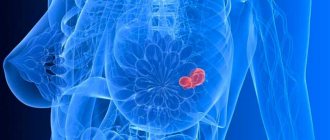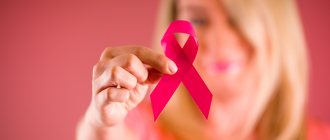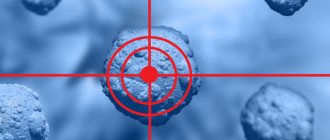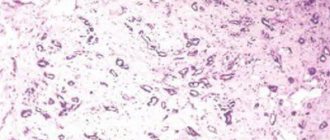CHEMOTHERAPY
Chemotherapy is exclusively treatment with cytostatics (drugs that are used primarily to suppress the rapid, uncontrolled growth of malignant tumor cells).
Chemotherapy for breast cancer is one of the main methods of combating breast cancer. The use of chemistry is possible as a separate type of therapy, or in combination with surgery, radiation therapy and symptomatic therapy.
Chemotherapy is based on the introduction into the body (intravenously, intramuscularly, in the form of tablets) of potent drugs that can destroy cancer cells (metastases) and block their spread.
It is known that cancer cells grow rapidly and spread throughout the body; therefore, radical treatment is not enough; in this case, chemotherapy is used as an auxiliary method, which is carried out in courses and affects the entire body, simultaneously killing cancer cells along the way. , which are localized in any part of the body.
Chemistry colors
Chemotherapy drugs and the therapy itself are also divided by color. So, for example, red is the strongest, most effective, based on alkylating drugs, but at the same time the side effects from it are the greatest. Here are examples of other types of chemistry by color:
- Red – Epirubicin
- Blue – Cyclophosphamide
- Yellow – Fluorouracil
- White – Taxol
Typically, the doctor alternates types of chemotherapy to achieve the maximum effect of treating the breast. In addition, such alternation will not only ease the load on the patient’s body, but will also prevent possible addiction to the drugs.
Red therapy is the main choice in the treatment of breast cancer. It is the use of this chemistry in recent years that has significantly reduced mortality from this type of oncology.
GOALS OF CHEMOTHERAPY
Reducing tumor size before surgery or radiation therapy;
destruction of microscopic cancer cells that may remain after surgery or radiation;
Destroying cancer cells that have re-formed or spread to other parts of the body.
Controlling tumor growth when treatment is not possible.
Relieving symptoms of cancer, such as reducing the size of a tumor that is causing pain or putting pressure on organs.
Consequences and complications
Chemotherapy treatment usually comes with severe side effects. This is not accidental; the action of toxic chemicals is aimed at destroying cancer cells, but unlike targeted therapy, there is a general effect on the healthy cells of the patient’s body. This influence leads to unpleasant complications. And the more courses and the dose received, the worse the tolerability will be.
But not everything is so bad - all people tolerate it differently, and some do not even feel any difference from the treatment. But the main thing to remember is the effectiveness of the treatment itself against carcinoma - and this should really motivate you to overcome any difficulties. In addition, it is the chemistry that finishes the tumor to the end, without even giving it a chance for further recovery and relapses.
And here is the list of side effects that the patient may encounter:
- Nausea and vomiting are the most faithful guest of chemotherapy.
- Constipation and diarrhea - in general, the work of the gastrointestinal tract is especially susceptible to chemistry.
- Loss of appetite, taste, and against this background, weight loss.
- Hormonal imbalance, and with it a change in the menstrual cycle.
- Fatigue and drowsiness.
- Decreased immunity due to the effect on the level of leukocytes, and hence susceptibility to disease.
- Temperature increase.
- Anemia.
- Bleeding and hematomas throughout the body.
- Baldness is one of the most frightening diseases for women.
We have already written an excellent article about recovery after chemotherapy. It describes in great detail what to do if certain post-treatment symptoms arise and how to restore your normal state after chemotherapy. Here we will only say that much of the list above can be eliminated with the same pills that the doctor will prescribe if necessary.
TYPES OF CHEMOTHERAPY
Chemotherapy has several types, which depend on the severity of the disease:
- 1. Neoadjuvant - prescribed, as a rule, before surgery. The melon type of chemistry is aimed at stopping and blocking cancer cells.
- 2. Adjuvant - prescribed mainly after surgery for breast cancer, as well as as a prophylaxis.
- 3. Therapeutic - prescribed mainly at stages 3 and 4 of the ocular process, when the malignant tumor is larger and distant metastases are present.
- 4. Preventive chemotherapy - carried out to prevent relapses of breast cancer.
In medical practice, chemotherapy is conventionally divided by color. "Chemistry" can be red, blue, yellow and white. The standard colors indicated correspond to the colors of the medication used.
- Red chemotherapy is the most powerful type of treatment, which is also accompanied by a toxic effect on the body. With this “chemistry”, Doxorubicin, Idarubicin or Epirubicin are used. After such treatment, weakness and decreased functioning of the immune system occur.
- Blue “chemistry” involves the use of Mitoxantrone or Mitomycin.
- Yellow chemotherapy usually uses medications called Fluorouracil, Methotrexate, or Cyclophosphamide.
- White “chemistry” involves the use of Taxol or Tacosel.
As a rule, the chemotherapy course is combined, i.e. it involves 2 or more medications.
What is the course of chemotherapy for breast cancer?
During a chemotherapy course, a woman lives her previous life without losing her ability to work.
Although doctors recommend administering the drugs on Fridays, so that if adverse reactions occur, the patient has time to recover and rest.
- Before administering the drug, a woman’s blood pressure and pulse, weight and height are measured in order to accurately calculate the dosage of the administered chemotherapy drug.
- Before treatment, mandatory premedication is prescribed using drugs that minimize adverse reactions.
- The patient is placed on the couch and given an infusion (through a drip) of a chemotherapy drug.
- After each course of treatment, the woman undergoes blood tests to study the level of leukocytes.
- When taking Cytoxan and some other drugs, in order to reduce the severity of adverse reactions, the patient will have to drink as much water as possible.
CHEMOTHERAPY DRUGS
When a chemotherapist uses only one drug for treatment, it is monochemotherapy. More often, doctors prefer a combination of several drugs with different mechanisms of action in order to kill a cancer cell at different periods of its life and in different ways: deprive it of a necessary enzyme, block the energy source, destroy the membrane. This option is called polychemotherapy or combination therapy.
Which drug will be prescribed depends on:
- size of the malignant tumor (chemotherapy for stage 1 or 2 breast cancer);
- spread of metastases;
- damage to the lymph nodes;
- hormonal state of a woman;
- type and main purpose of therapy.
The frequency and duration of chemotherapy depends on:
- type and stage of cancer;
- treatment goals (what chemotherapy is used for: to treat cancer, control its progression, or relieve symptoms);
- type of chemotherapy
- the patient's body's response to chemotherapy.
Chemotherapy is given in cycles. During the cycle, patients may receive treatment daily, weekly, or monthly. Each treatment cycle is followed by a rest period. This period of rest gives the body the opportunity to form new healthy cells.
Typically, the number of treatment cycles performed depends on:
- stages of breast cancer;
- tumor aggressiveness;
- patient's health status.
Courses of therapy range from 2 to 7, in some cases it is possible to increase them to 9.
General information about the procedure
Chemotherapy for breast cancer is the effect of chemotherapy on mutated cells that have become the causative agent of cancer, leading to their death.
The composition of chemotherapy drugs is designed in such a way that toxic substances have a greater effect on the cancer and less on the healthy organs of the body.
Chemotherapy is carried out in courses (cycles), since cancer cells are in constant division and one course of treatment, as a rule, is not enough to completely destroy metastases. How many courses of chemotherapy for breast cancer are necessary can only be determined by the attending physician - an oncologist.
Typically, the number of treatment cycles performed depends on:
- stages of breast cancer;
- tumor aggressiveness;
- patient's health status.
Courses of therapy range from 2 to 7, in some cases it is possible to increase them to 9.
PREPARATION AND CONDUCT OF CHEMOTHERAPY
The standard scheme of cytostatic therapy is simple:
- 1. A woman meets with a doctor consultant.
- 2. During the consultation, the doctor must notify the patient about the possible side effects and benefits of therapy.
- 3. The doctor appoints a day on which the procedure will be performed. Immediately before starting antitumor therapy, it is necessary to measure blood pressure, respiratory rate, pulse and body temperature. The height and weight of the patient also plays a significant role.
Based on these data, the dose of the medicine is selected.
Contraindications to chemotherapy
There are certainly contraindications for both chemotherapy for breast cancer and other medications. This is due to the fact that this procedure is not able to help in all cases. The risk of relapse is always present. Therefore, in most cases, the use of antitumor drugs as a separate method of therapy is ineffective.
For hormone-dependent breast cancer, chemotherapy is not relevant, since there is no effect from the treatment. I repeat, it all depends on the age and health status of the patient.
Girls and women of the younger generation who suffer from hormonal-dependent forms of cancer have reduced levels of estrogen and progesterone. In this case, you have to use other methods. Thus, ovarian function is suppressed with the help of medications. Surgical removal of the ovaries is prescribed, as well as taking medications that block the effect of sex hormones. Therefore, such patients are not prescribed chemotherapy for breast cancer.
After completing all the above steps, you can put in a dropper with the medicine. At the end of the drug administration, the intravenous catheter is removed from the vein and the person can go home. This is the standard chemotherapy regimen for breast cancer.
Carrying out chemotherapy for breast cancer
When prescribing a course of chemotherapy, the following factors are taken into account:
- The size of the tumor focus and the degree of invasiveness.
- Degree of cancer differentiation. Histological affiliation of cells.
- The presence of metastases in the lymph nodes and distant areas of the body.
- Tumor sensitivity to hormonal drugs. Chemotherapy may not be the main means of achieving the goal.
- Rate of cell growth and proliferation.
- The patient's age and degree of ovarian functionality.
Before starting treatment, the condition of the cardiovascular system, as well as the kidneys and liver is diagnosed. The drugs are administered intravenously, so the woman is given a catheter, which is not removed during the entire course. Treatment can be carried out in a hospital or on an outpatient basis, depending on how you feel.
Chemistry before surgery
Neoadjuvant therapy before surgery is prescribed for metastatic oncology and large tumor size. Preparation for chemotherapy for breast cancer begins immediately after the diagnosis of triple-negative breast cancer. In this form of oncology, the tumor does not respond to any traditional treatment methods, since the cells do not have receptors for hormones and growth factors. Treatment must be carried out immediately, since atypical cells of triple-negative breast cancer divide at a high rate and quickly metastasize.
Aggressive forms of breast tumors include poorly differentiated intraductal carcinoma and basal cell carcinoma.
Such tumors, having no receptors for hormonal drugs, exhibit high sensitivity to cytostatic drugs that act on the DNA of the atypical cell and stop the division process. According to statistics, it was possible to achieve three-year survival in 63% of women without tumor recurrence. Until now, scientists cannot understand why, with high sensitivity to chemistry, the overall survival rate in patients is lower.
SIDE EFFECTS AFTER CHEMOTHERAPY
Chemotherapy, especially in the early stages, can help a woman completely get rid of breast cancer, so it is possible and necessary to endure the side effects. Often they are expressed in:
- decrease in platelets;
- decrease in hemoglobin;
- hair loss (alopecia);
- menstrual irregularities, up to the onset of menopause;
- fatigue, weakness, drowsiness.
Complications include frequent nausea, vomiting, and decreased functioning of the immune system. Against the background of decreased immunity, infectious diseases and damage to internal organs and organ systems are possible.
Any type of chemotherapy affects the body with toxic and poisonous substances, as a result of which side effects occur. Side effects depend on the amount, cycles of chemotherapy, dosage and types of drug.
The most common side effects include:
- nausea and vomiting;
- loss of appetite;
- upset stomach, diarrhea, constipation;
- baldness (hair loss);
- set on edge;
- changes in the menstrual cycle;
- changes in the endocrine system;
- high susceptibility to various infections;
- fatigue, lethargy, fatigue;
- increased temperature, fever;
- suppression of ovarian function;
- anemia;
- bruising or bleeding.
To relieve symptoms after chemotherapy, use the properties of symptomatic drugs that have an antiemetic effect or prescribe vitamins.
Consequences
Chemotherapy treatment does not go away completely for patients.
It involves the systemic administration of toxic and noxious substances, and therefore causes many consequences and adverse reactions.
Adverse reactions are especially pronounced in patients who undergo chemotherapy in several courses and with high dosages.
But breast cancer tends to recur, and chemotherapy helps prevent the tumor from forming again. Therefore, even with pronounced adverse reactions, the chemotherapy course is carried out to the end.
Among the most common adverse reactions, patients name:
- Nausea and vomiting syndrome;
- Gastrointestinal disorders, constipation, diarrhea;
- Reversible alopecia;
- Lack of appetite, taste changes, aversion to previously favorite foods;
- Feeling set on edge;
- Endocrine disorders and menstrual changes;
- Fatigue, lethargy and increased fatigue;
- Tendency to infectious diseases;
- Feverish state, hyperthermia;
- Bleeding, hematomas, bruises;
- Anemic disorders;
- Suppression of ovarian functions.
To facilitate the clinical course of adverse reactions, women are prescribed symptomatic drugs such as antiemetics and vitamin complexes. Chemotherapy is contraindicated in patients with hormone-dependent breast cancer; in such cases, hormone therapy methods are used.










